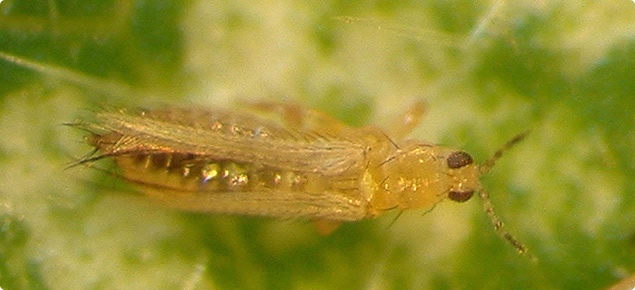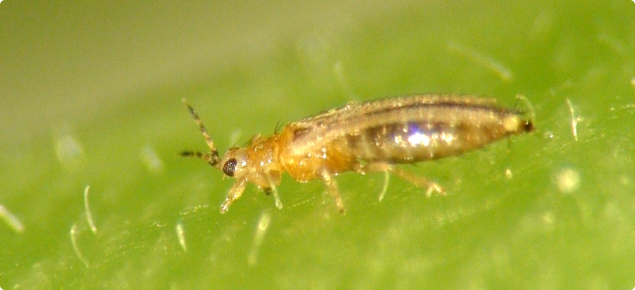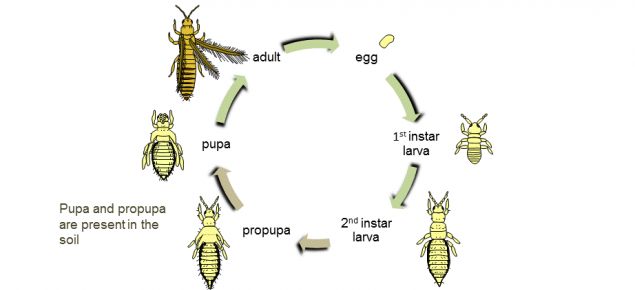Problems with chemical control
- Western flower thrips is very difficult to control with pesticides because pupae are present in the soil, eggs are inserted into the plant tissue, and larvae and adults hide within flowers and in leaf crevices where pesticide penetration is poor.
- Western flower thrips has a high reproductive rate and a life cycle that is almost continuous, particularly in greenhouses. All life stages can be found year-round. In Western Australia, populations tend to peak in spring (mid-late October) and autumn (March-May). A female lives for 30 to 45 days and can produce 150 to 300 eggs during her lifetime.
- Western flower thrips has developed resistance to pesticides in all major chemical classes. In Australia these include synthetic pyrethroids, organophosphates, carbamates, and the newer, narrow-spectrum pesticides such as spinosad.
- When populations develop resistance to one or more pesticides, this usually has a negative impact on Integrated Pest Management (IPM) programs that have chemical control as one of the components.
- Management to prevent or delay the development of resistance is necessary for increasing the chances of effective chemical control.
Management strategies
Biological control
The most effective strategy is to incorporate biological control into management. Several species of beneficial insects and mites have become commercially available in Australia. These include predatory mites that feed on the thrips larvae (Transeius montdorensis, Neoseiulus cucumeris), or pupae (Hypoaspis spp. also known as Stratiolaelaps spp.).
Two species of pirate bug (Orius spp.) that feed on larval and adult thrips are also available. Consult Good Bugs for more information as species have specific crop, temperature and humidity requirements.
Mass trapping
Mass trapping involves distributing sticky traps over a large area such as a greenhouse. The method is currently being evaluated overseas for control of western flower thrips in greenhouse and field crops.
Cultural control
- Weeds provide refuge for western flower thrips and other pest insects. Either remove or control weeds within and near your crop/orchard.
- Plough in or burn old crop debris.
- Use insect-proof screening on your greenhouse. Screening is expensive and since you need to cover all vents and doorways, air circulation is reduced and extra venting may be required. Trials have indicated that the maximum hole size for the exclusion of thrips is 0.192mm.
Sterilise greenhouses between plantings
- Greenhouses should be sterilised between crop plantings. Sterilise or steam the soil to kill pupae.
- Alternatively keep the greenhouse hot, dry and empty for at least one week, or longer in cold weather. Any thrips in egg or pupal stages will hatch and subsequently die.
- Sticky traps should be placed in the empty greenhouse to attract many of the remaining adult thrips. It is important that the greenhouse contains no plant material for this strategy to work.
Chemical control
- Spray applications are only effective when thrips are actively feeding as larvae or adults. The application of a series of pesticide sprays increases the likelihood of larvae and adults coming into contact with the chemical.
- Like all insects, the rate that western flower thrips completes a life cycle depends on temperature. At higher temperatures thrips develop more quickly requiring a shorter length of time between sprays.
- The three spray strategy. To reduce resistance, it is recommended that growers spray three times consecutively with the same insecticide. Make consecutive applications at either 3-5 day intervals when temperatures are greater than 20°C, or at 6-12 day intervals when temperatures are less than 20°C.
- After three sprays, stop and monitor for western flower thrips over a 7-10 day period.
- There must be at least a three week break (at less than 20°C) or a two week break (above 20°C) before another series of sprays is applied. If monitoring indicates the need to spray earlier, then insecticide resistance, inappropriate spray application or inadequate hygiene should be suspected.
- Note that once harvesting has commenced, it may be difficult to follow the insecticide management plan recommended and observe withholding periods.
Which insecticides are registered?
- Insecticides registered for control of western flower thrips vary with crop. For this reason, recommendations are not provided here.
- This information is available from the APVMA or the InfoPest websites.
Hints for successful chemical control
- Take action before thrips become established.
- Reserve the insecticides recommended for the control of western flower thrips until you find it in your crop.
- Monitor your crop. If thrips are not present, then there is no need to spray.
- Use small droplets (less than 100 microns) rather than large droplets, as these are more effective. Droplet size can be checked using water sensitive paper.
- Spray in the early morning or mid to late afternoon. The leaves stay wet longer at these times which maximise exposure of the thrips to the insecticide.
- Do not mix insecticides! Mixing is likely to increase the levels of resistance in the thrips population since you are exposing thrips to multiple insecticides, rather than just one.
- Control thrips prior to flowering where possible. When thrips enter the flowers they are difficult to contact with insecticides as they are hidden.
- Check the pH of the water used in spraying as pH affects the activity of insecticides. A neutral pH is best (6.5-7.0).




